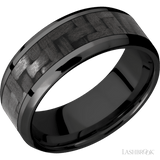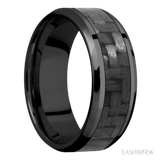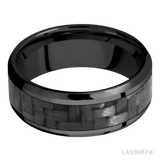
Zirconium is an element on the periodic table. It has incredible chemical resistance and does not readily react with solvents, acids, bases or other common chemicals. Such unique characteristics make zirconium a great material to use in exotic applications. Traditionally, it used as an alloy in nuclear reactors, submarines, and incendiary munitions.
Our zirconium rings are made using this same high-tech Zirconium alloy, which is comprised primarily of zirconium with a few trace elements. These unique combinations of metals make zirconium rings a perfect option for those with nickel and precious metal allergies and sensitivities.
In its natural state, zirconium is a silver-grey color. It earns its stark black appearance through our proprietary heating process, in which a layer of hard black oxide grows on the metal. This black layer is much harder than raw zirconium, but it is very thin. Unlike oxidized silver and black rhodium, this layer does not rub off over time. It is also more durable than black-coated rings, such as black titanium and black tungsten.
Zirconium is rated as an 8.5 on the Mohs Scale of Hardness.
Zirconium rings are hypoallergenic, lightweight, and comfortable. Zirconium rings should be treated as fine jewelry, and should be removed during harsh activities to avoid scratching.
Cleaning: Zirconium rings need no special care. These rings can be cleaned with regular jewelry cleaner, steam, or ultrasonic
Carbon fiber is a material with one of the highest strength-to-weight ratios of any product ever created.
Our carbon fiber rings utilize structural carbon fiber produced entirely in the United States. We source carbon fiber from local manufacturers whose products are found in high-tech applications varying from Formula 1 Racing and aerospace engineering to competitive cycling.
The raw material used to make carbon fiber is a mix of compounds, mostly consisting of organic polymers. This material is drawn into long strands, or fibers, and then heated in a controlled environment. The heat causes the atoms in the fibers to vibrate violently until most of the non-carbon atoms are expelled. The material left after the heating process is composed of thin tightly wound carbon strands which are then processed through stabilization, spinning, and weaving. For classic carbon fiber, the processing ends here with a resin application to bind the composite. For forged carbon fiber, the resin is applied after the processed carbon strands are cast into a random pattern to create a unique look. The development of forged carbon fiber allows further advancements in applications ranging from supercars (Lamborghini) to golf equipment (Callaway).
Carbon fiber rings are lightweight, strong, and durable.
Cleaning: Carbon fiber rings need no special care. These rings can be cleaned with regular jewelry cleaner, steam, or ultrasonic






